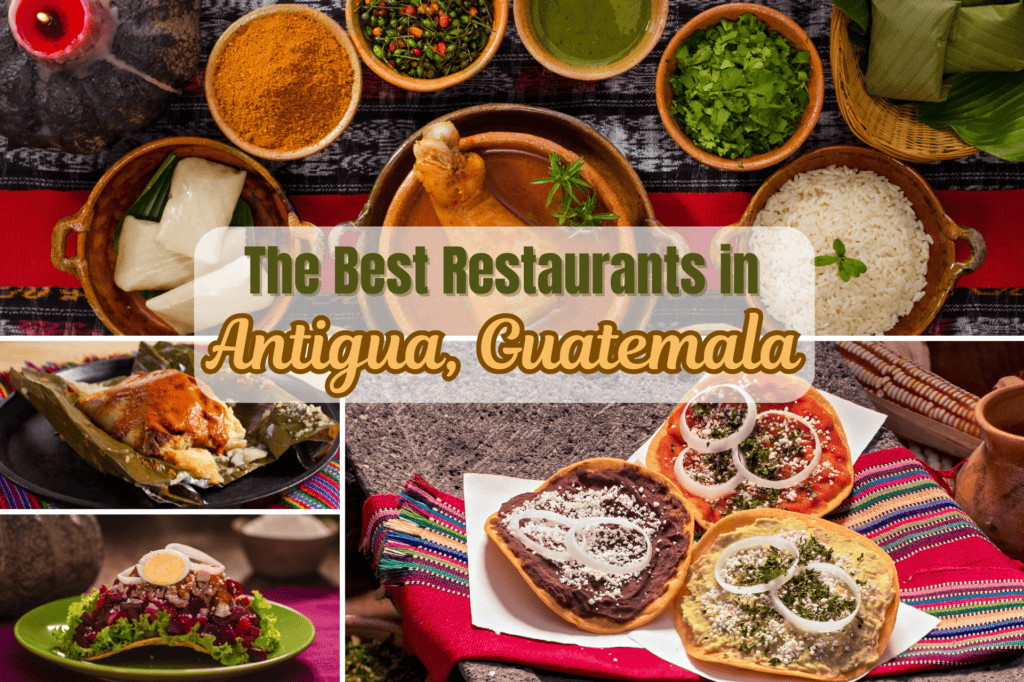Holy Week in Guatemala: Traditions & Celebrations Revealed
Holy Week in Guatemala or “Semana Santa” is a week-long festival that transforms the historic streets of Antigua into a pageant of devotion, you’ve come to the right place. You’ll witness here how a blend of indigenous traditions and Spanish colonial heritage crafts an event that draws visitors from all corners of the globe to Guatemala. Prepare to unravel the significance of the vibrant alfombras, the solemn processions, and the communal spirit that marks this as a cornerstone of Guatemalan culture.

If you are interested in visiting Antigua, Guatemala check out my article Antigua Guatemala: Discover the 6 Top Best Places to Visit 2024
Key Takeaways
Semana Santa, or Holy Week, in Antigua, Guatemala is a significant cultural and spiritual event marked by centuries-old traditions, processions, and communal artistry from March 24 to March 30 this year 2024
The alfombras (colorful, intricate carpets made of natural materials) are central to the celebrations, symbolizing both artistic expression and the fleeting nature of life as they are destroyed by the processions.
The celebrations of Semana Santa encompass a mix of solemn religious observances and vibrant festivities, reflecting a unique cultural history that blends Spanish colonial and indigenous traditions.
Table of Contents
Exploring Semana Santa in Antigua, Guatemala

The ancient city of Antigua, nestled in the heart of Guatemala, buzzes with anticipation as it gears up to host a gathering that’s both spectacular and deeply spiritual. Semana Santa, or Holy Week, is an event marked by a profound sense of devotion and artistry, recognized globally for its outstanding cultural value. Between March 24 and March 30, 2024, the city will transform into a stage for an array of rituals and processions, each mirroring the profound sacredness of this time.
A story preserved through centuries is told by the streets of Antigua; it’s a narrative of faith intricately woven into the fabric of Guatemalan culture. Residents and visitors alike are drawn into the communal spirit that percolates through Guatemala City and its surroundings. The meticulous preparations and public representations of the holy observances are a testament to the enduring legacy of this week-long celebration. It’s a time when the past and present, the sacred and the communal, converge in a spectacle of shared humanity.
The Arrival of Semana Santa Traditions
The arrival of Semana Santa in Central America, particularly in the República de Guatemala, is a historical milestone that dates back to the year 1524. It was then that the Spaniards brought this profound tradition to the shores of the New World, planting the seeds of what would become an integral part of the cultural landscape of eastern Guatemala.
Etched indelibly into the nation’s identity, these traditions have been conscientiously preserved and relayed from one generation to the next. The Holy Week observances are not just a celebration but a cornerstone of Guatemalan culture that resonates with the echoes of its historic journey from Spain to the bustling streets of Antigua.
Holy Week Foods and Flavors

Amidst the spiritual and cultural observances, the flavors of Semana Santa offer a sensory journey through Guatemalan cuisine. The week is filled with traditional sweet treats like ‘ayote en dulce’, a delectable dessert made from pumpkin and panela, and fruits prepared in honey that delight the palate.
Savory dishes are also a staple, with fairs offering a variety of foods such as:
- Atol (rice porridge)
- Tamales
- Enchiladas
- Chiles Rellenos
- Tostadas
These culinary delights are as much a part of the holy week observances as the processions and prayers, uniting people through the shared experience of traditional Guatemalan fare.
If you are interested in trying the local foods in Antigua, Guatemala check out the Street Food Evening Tour in Antigua, Guatemala in my article Antigua Guatemala: Discover the 6 Top Best Places to Visit 2024

The Artistry of Alfombras
One of the most captivating spectacles of Semana Santa is the creation of alfombras, a tradition that showcases the artistic soul of the Guatemalan people. These intricate carpets, crafted from colored sawdust, pine needles, and an array of fresh flowers, fruits, and vegetables, are more than just decorative elements; they are a canvas upon which biblical scenes and Mayan traditions are vividly brought to life.
The process of creating an alfombra involves:
Families, businesses, and church brotherhoods coming together
Contributing their creativity and dedication
Each alfombra being a unique masterpiece
A reflection of the collective spirit of those involved
It is a labor of love and a collaborative community endeavor, showcasing the time and talent devoted to this ephemeral art form. For more information, see the main article on this topic, available on wikipedia the free encyclopedia.
However, these stunning creations are ephemeral. As the processions pass over them, the alfombras are destroyed, a poignant reminder of the fleeting nature of life. The destruction is intentional, a symbolic act that is as profound as it is visually stunning, teaching a lesson in humility and transience with every crushed petal and dispersed grain of sawdust.
Vigils and Processions
The religious vigils of Lent are a prelude to the crescendo of Semana Santa, setting the tone for the holy week observances. Every Friday and Sunday, starting from Ash Wednesday, many churches of Antigua open their doors to the faithful, inviting them to partake in prayer and reflection before sacred sculptures, each adorned to commemorate passages from the Bible.
The processions are the heartbeat of Semana Santa, a moving display of devotion and penance. Participants bear the weight of the floats, or andas, which carry elaborate religious figures, including Jesus Christ and the Virgin Mary. The burden of these floats is not just physical but also spiritual, as each step taken by the procession bearers is an act of deep veneration.
Cucuruchos, identifiable by their purple cloaks and the incense they carry, are a signature element of these processions. Organized by the brotherhood of each church, funeral marching bands accompany these solemn marches, their haunting melodies adding to the poignancy of the scenes depicted. This is a manifestation of faith that engages all the senses, leaving a lasting impression on all who witness it.
Palm Sunday: The Triumphal Entry

Palm Sunday marks the threshold of Holy Week, a day that commemorates the triumphal entry of Jesus into Jerusalem. In Antigua, this day is met with a fervent display of piety as locals gather palm leaves, carefully weaving them with flowers to create bouquets that are blessed, echoing the biblical narrative. As Passion Sunday, it also serves as a reminder of the events leading up to the crucifixion of Jesus.
The processions on this day are a grand affair, with andas showcasing the revered images of the Holy Virgin of Sorrow and Jesus of Nazareth. The curcuruchas, devotees clad in purple, shoulder these sacred representations through the city, their solemn march a re-enactment of a story that has been told for millennia.
This day sets the stage for the week to come, a poignant reminder of the journey that lies ahead. It is an invocation of the spirit of Easter Sunday and the holy week observances that are deeply ingrained in the hearts of the people of Antigua.
Good Friday: A Day of Mourning and Reflection

Good Friday in Antigua is a stark contrast to the colorful celebrations earlier in the week. It is a day draped in black, as the cucuruchos exchange their purple robes for ones of mourning. This act signifies the community’s shared grief over the crucifixion of Jesus, setting a somber tone across the city.
The vibrant decorations that once adorned the streets during Maundy Thursday are replaced with mournful black adornments. This transformation is a silent testament to the reflective mood of Good Friday, as the entire city communes in solemn remembrance.
The processions of the day are a somber re-enactment of Christ’s crucifixion. Floats depicting Jesus bearing the cross navigate the streets, accompanied by marching bands whose melodies evoke introspection.
The day’s events culminate in the laying to rest of the figure of Jesus, a symbolic gesture that invites contemplation and reverence.
Holy Saturday and Easter Sunday: From Sorrow to Celebration

The transition from the sorrowful observances of Good Friday to the jubilant celebrations of Easter is a defining characteristic of Semana Santa in Antigua. As the clock strikes 10 pm on Holy Saturday, churches herald the beginning of the celebration of Jesus’ resurrection, marking a pivotal moment in the week’s events.
This shift in atmosphere is palpable, as the somber processions give way to the exuberance of Easter Sunday. The air is filled with a sense of renewal and joy, a stark departure from the reflection and mourning of the preceding days.
Easter Sunday is characterized by vibrant festivities. The people of Antigua greet the day with smiles, children wave colorful flags, and the sky is lit with the brilliance of fireworks. It is a day of celebration, a culmination of the Holy Week observances that resonates with hope and the triumph of life over death.
The Cultural Tapestry of Holy Week in Guatemala

The Semana Santa celebrations in Antigua are a rich tapestry of cultural history, where Spanish colonial traditions are interwoven with indigenous beliefs. This fusion creates an elaborate celebration that is revered as one of the most impressive in the world.
The worship of the folk saint Maximón, also known as Rilaj Mam, during Semana Santa in Latin America is a striking example of this cultural synthesis. This tradition exemplifies the harmonious blend of Indigenous and Roman Catholic Church customs, which together form a vibrant cultural mosaic.
The spirit of tolerance and inclusion that permeates Semana Santa in Antigua encourages participation from all social groups. This inclusivity fosters a sense of mutual respect and unity within the community, reinforcing the idea that despite our differences, we can come together in shared experiences and traditions.
Religious Significance and Community Involvement
Holy Week in Antigua holds profound religious significance, with the entire period devoted to the remembrance of the Passion of Jesus Christ. It is referred to as the Great Week, a time that commemorates the transformative deeds performed by God.
The church brotherhoods, particularly in western churches, are the backbone of the Holy Week events, coordinating the meticulous details of the processions and ensuring the traditions are carried out with reverence and precision. Their role is vital in fostering a sense of community and in passing down these sacred rituals to the next generation.
The celebrations of Semana Santa are a reflection of Guatemala’s cultural diversity. They resonate deeply with themes of pain and hope, serving as a symbol of the unity and resilience of the Guatemalan people. It is a time that brings together Christians from all walks of life, joining in a shared expression of faith and camaraderie.
Summary
As we conclude this journey through the sacred and vibrant traditions of Semana Santa in Antigua, Guatemala, we carry with us the images of alfombras, the sounds of processions, and the taste of traditional foods. The Holy Week observances in this historic city are a testament to the enduring spirit of a culture that celebrates life, mourns death, and ultimately triumphs in the resurrection. It is a cultural tapestry that invites us to reflect on the beauty of shared human experiences and the power of faith to unite us across boundaries.
Frequently Asked Questions
What are the 7 days of Holy Week?
The 7 days of Holy Week are Palm Sunday, Holy Monday, Holy Tuesday, Holy Wednesday (also known as Spy Wednesday), Maundy Thursday (Holy Thursday), Good Friday, and Holy Saturday (or Black Saturday). Christians might also observe the Easter Vigil late Saturday night preceding Easter Sunday.
Is Guatemala a part of Mexico?
No, Guatemala is not a part of Mexico. After a period of being part of the United Provinces of Central America, Guatemala became an independent nation in 1838.
Is Guatemala a friend of the US?
Yes, Guatemala and the United States have traditionally close relations, and Guatemala generally supports U.S. positions in international forums. The U.S. also has an embassy in Guatemala City.
What is Guatemala known for?
Guatemala is known for its unique heritage, natural beauty, and tropical weather, making it a popular destination for culture lovers.
What is the historical significance of Semana Santa in Antigua, Guatemala?
The historical significance of Semana Santa in Antigua, Guatemala lies in its preservation and transmission of religious practices that date back to the arrival of Spanish traditions in 1524, creating a vibrant cultural heritage that has been celebrated for centuries.






